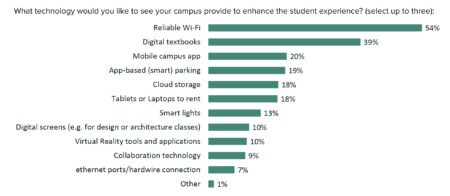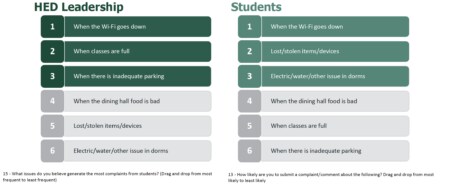From move-in day to graduation day, students require reliable Wi-Fi to be successful. Not only does Wi-Fi enable effective collaboration and creativity, but it can also be a driver to attract and retain students and faculty to campus. As the need for seamless connectivity on college and university campuses continues to expand, are schools measuring up to student expectations? We wanted to find out.
In partnership with the Center for Digital Education, Cisco Meraki conducted two surveys, one of higher education decision-makers and one of college students — to better understand students’ habits and needs regarding network use and technology and how that compares to what their counterparts in leadership perceive. We asked almost identical questions of these two audiences and compared the results.
The results were fascinating. While the full survey report outlines many interesting findings, three key things stood out that warranted further analysis:
1. Students aren’t utilizing campus to its full potential because of unreliable Wi-Fi
We asked students where they complete their school work and use Wi-Fi the most. We then asked higher education leaders where they think students complete their school work and use the Wi-Fi the most. Both audiences were also asked how reliable they thought the Wi-Fi was in those areas. Surprisingly, the study showed a large discrepancy between the students actual Wi-Fi use and the leaders perception of what the students use. While the vast majority of students ranked the school library, on campus housing, and off-campus housing as the top three locations to work and use Wi-Fi, the leaders listed study rooms and dining/common areas as primary student work locations. Why aren’t students completing school work and using Wi-Fi in all of the areas leadership thinks they are?
When asked how reliable the Wi-Fi was in the same locations, the discrepancy was shocking. In every location highlighted, more than half of leaders thought Wi-Fi was very reliable, yet less than 25% of students thought so (with the exception of the library). More specifically, 40% of leadership versus 22% of students think Wi-Fi is highly reliable in dorms and 42% of leadership think Wi-Fi is somewhat reliable outdoors, while 57% of students say there is no outdoor Wi-Fi. To top it off, when students were asked “What technology would you like to see your campus provide to enhance the student experience?” the top answer, getting 54% of the responses, was reliable Wi-Fi.

While students want to seamlessly roam from their dorm room, to class, to the outdoor quad and have reliable connections in order to socialize and work, this isn’t being provided to the standard students expect. In order to provide the best experience for students, reliable Wi-Fi everywhere on campus is key.
2. While Wi-Fi is important, schools can’t forget about the wired network
Students are bringing more and more wireless devices with them to campus, especially when they live in dorms. On average, students who live on campus bring 9 devices with them to school, while those who commute bring an average of 3. The survey showed that students and higher education leaders were aligned on the top two devices students bring to campus (laptops and smartphones), but the third device was surprising. For students living on campus, 43% bring a desktop computer, a large difference from the 18% predicted by education leaders. Instead, leadership overestimated students bringing other wireless technologies, like tablets, video game consoles, and smart watches.
While the number of wireless technologies students bring to school will continue to increase, schools can’t forget about the wired network. Students still demand a wired connection, especially in their dorm rooms. Plus, a reliable network backbone is key to supporting high-density wireless access points everywhere on campus. Ensuring the underlying wired network is ready for what students will throw at it is just as important as the wireless.

3. Improving campus Wi-Fi can greatly reduce the number of help desk tickets
Students on average submit 11 help desk tickets per year, on par with higher education leaders’ estimations of 13 tickets a year. This means that students are submitting help desk tickets around once a month, and when you multiply that by the number of students, the amount of tickets is staggering. It’s no surprise that students and leaders agree that most tickets are submitted when the Wi-Fi goes down.

By providing always-on connections, students will complain less about the Wi-Fi and in turn, submit less tickets. This not only saves on IT resources, but gives those teams time back in their day to work on more proactive and impactful projects that can benefit the university.
Overall, the surveys found that students want to see reliable Wi-Fi on campus to enhance their experience, and they are not getting the always-on connection higher education leaders believe they’re providing. But it’s not too late to turn this around – higher education institutions can start by evaluating solutions that provide the access students deserve, while being easier for the IT team to set up and manage.
To see the numbers and glean more insights from the survey, join an upcoming live webinar with the Director of Product Management for Meraki Wireless. Register Now!
